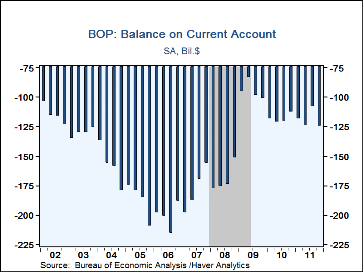 Global| Mar 14 2012
Global| Mar 14 2012U.S. Current Account Deficit Deteriorates Slightly
by:Tom Moeller
|in:Economy in Brief
Summary
The U.S. current account deficit rose last quarter to $124.1B from $107.6B in Q3 as a modest gain in imports outpaced a slight export decline. Consensus expectations were for $114.2B in Q4. The ratio to GDP last quarter was 3.2%, [...]
The U.S. current account deficit rose last quarter to $124.1B from $107.6B in Q3 as a modest gain in imports outpaced a slight export decline. Consensus expectations were for $114.2B in Q4. The ratio to GDP last quarter was 3.2%, roughly the same as for all of 2010. The overall deficit's increase occurred as the goods deficit in Q4 deepened to $186.3B.
For all of last year, the current account deficit of $473.4B still was nearly half that five years ago. Last year's rough stability versus 2010 occurred as merchandise balance deterioration was offset by services & income improvement. The deficit on goods trade deepened to $738.3B from $645.9B. Goods exports rose 16.2%, driven by the lower value of the dollar, and merchandise imports rose 15.6%, driven by higher oil prices. The surplus on services trade improved for the year to $178.3B from $145.8B as exports rose 10.7% and imports increased 6.5%. The balance on income improved to $221.1B from $165.2B.
From the capital account, 2011 saw $783.7B paid to foreigners on investment in the U.S. which by far exceeded $396.4B in payments to the U.S. The imbalance largely reflects foreign ownership of U.S. financial assets. Payments on U.S. direct investment abroad totaled $406.2B while payments on foreign direct investment in the U.S. were $227.9B.
Balance of Payments data are in Haver's USINT database, with summaries available in USECON. The expectations figure is in the AS1REPNA database.
| US Balance of Payments SA | Q4'11 | Q3'11 | Q2'11 | Year Ago | 2011 | 2010 | 2009 |
|---|---|---|---|---|---|---|---|
| Current Account Balance($Bil.) | -124.1 | -107.6 | -123.4 | -113.3 | -473.4 | -470.9 | -376.6 |
| Deficit % of GDP | 3.2% | 2.8% | 3.3% | 3.0% | 3.1% | 3.2% | 2.7% |
| Balance on Goods ($Bil.) | -186.3 | -180.9 | -189.7 | -159.2 | -738.3 | -645.9 | -505.9 |
| Exports | -0.6% | 2.6% | 3.2% | 11.0% | 16.2% | 20.5% | -18.2% |
| Imports | 0.6% | 0.2% | 3.7% | 12.9% | 15.6% | 22.8% | -26.3% |
| Balance on Services ($Bil.) | 45.3 | 46.2 | 44.5 | 40.5 | 178.3 | 145.8 | 124.6 |
| Exports | -0.3% | 3.0% | 3.3% | 9.1% | 10.7% | 8.6% | -5.5% |
| Imports | 0.3% | 2.8% | 2.6% | 8.0% | 6.5% | 5.8% | -5.6% |
| Unilateral Transfers ($Bil.) | -33.3 | -33.5 | -35.5 | -33.4 | -134.6 | -136.1 | -123.3 |
Tom Moeller
AuthorMore in Author Profile »Prior to joining Haver Analytics in 2000, Mr. Moeller worked as the Economist at Chancellor Capital Management from 1985 to 1999. There, he developed comprehensive economic forecasts and interpreted economic data for equity and fixed income portfolio managers. Also at Chancellor, Mr. Moeller worked as an equity analyst and was responsible for researching and rating companies in the economically sensitive automobile and housing industries for investment in Chancellor’s equity portfolio. Prior to joining Chancellor, Mr. Moeller was an Economist at Citibank from 1979 to 1984. He also analyzed pricing behavior in the metals industry for the Council on Wage and Price Stability in Washington, D.C. In 1999, Mr. Moeller received the award for most accurate forecast from the Forecasters' Club of New York. From 1990 to 1992 he was President of the New York Association for Business Economists. Mr. Moeller earned an M.B.A. in Finance from Fordham University, where he graduated in 1987. He holds a Bachelor of Arts in Economics from George Washington University.








